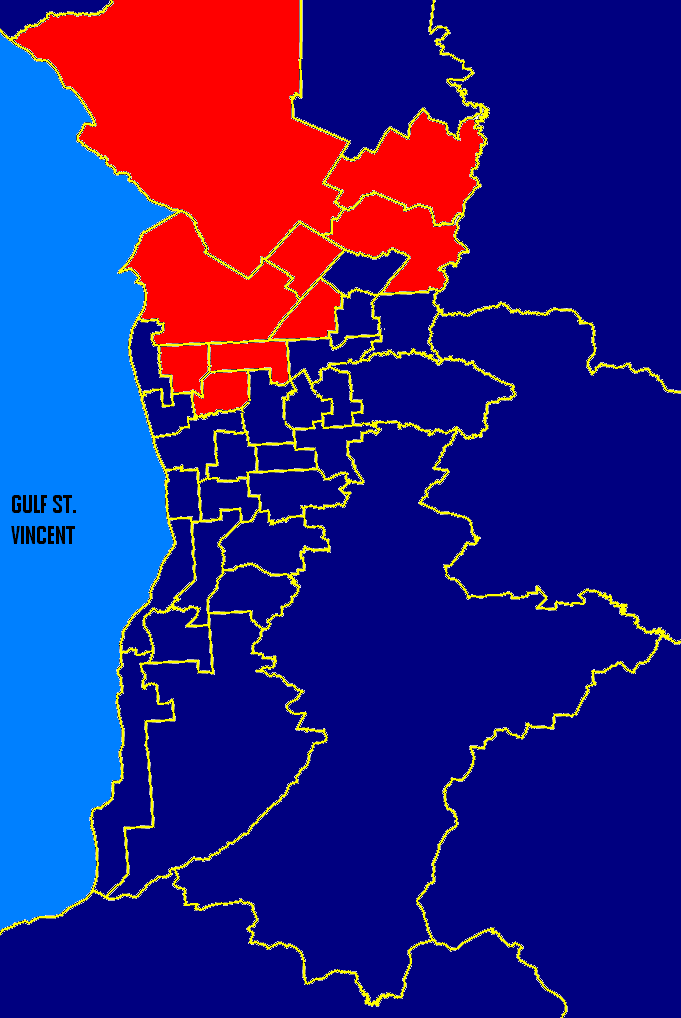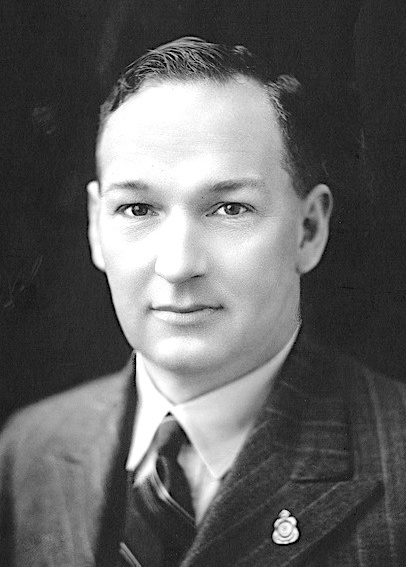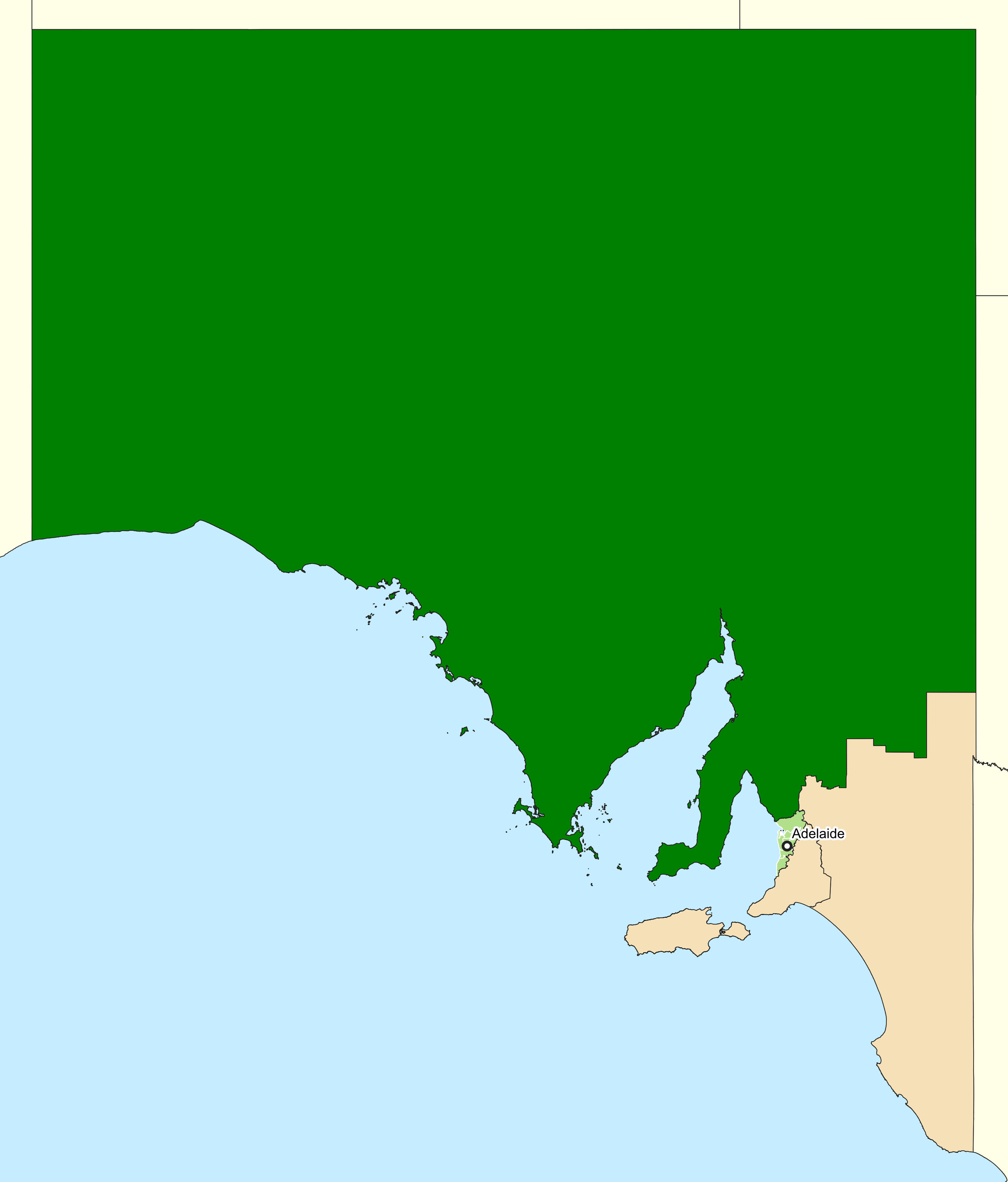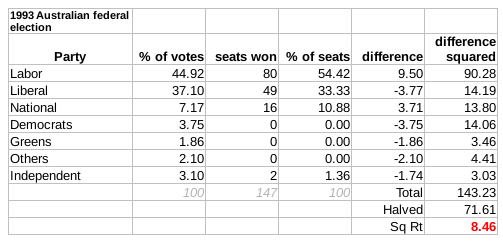|
1993 South Australian State Election
State elections were held in South Australia on 11 December 1993. All 47 seats in the South Australian House of Assembly were up for election. The incumbent Labor government, led by Premier Lynn Arnold, was defeated by the Liberal Opposition, led by Dean Brown, in a landslide victory. The Liberals won what is still the largest majority government in South Australian history. Background The campaign was dominated by the issue of the collapse of the State Bank of South Australia in 1991. The State Bank's deposits were legally underwritten by the Government of South Australia, putting South Australia into billions of dollars of debt. Labor premier John Bannon had resigned over the issue in 1992, being replaced by Lynn Arnold just over a year before the election. The Liberals also changed leaders in 1992, switching from Dale Baker to Dean Brown. Following the Labor leadership change and by early 1993, Newspoll had recorded a total rise of 13 percent in the Labor primary vote. ... [...More Info...] [...Related Items...] OR: [Wikipedia] [Google] [Baidu] |
South Australian House Of Assembly
The House of Assembly (also known as the lower house) is one of two chambers of the Parliament of South Australia, the other being the Legislative Council. It sits in Parliament House in the state capital, Adelaide. Overview The House of Assembly was created in 1857, when South Australia attained self-government. The development of an elected legislature — although only men could vote — marked a significant change from the prior system, where legislative power was in the hands of the Governor and the Legislative Council, which was appointed by the Governor. In 1895, the House of Assembly granted women the right to vote and stand for election to the legislature. South Australia was the second place in the world to do so after New Zealand in 1893, and the first to allow women to stand for election. (The first woman candidates for the South Australia Assembly ran in 1918 general election, in Adelaide and Sturt.) From 1857 to 1933, the House of Assembly was elected from mult ... [...More Info...] [...Related Items...] OR: [Wikipedia] [Google] [Baidu] |
Government Of South Australia
The Government of South Australia, also referred to as the South Australian Government or the SA Government, is the executive branch of the state government, state of South Australia. It is modelled on the Westminster system, meaning that the highest ranking members of the executive are drawn from an elected Parliament of South Australia, state parliament. Specifically the party or coalition which holds a majority of the South Australian House of Assembly, House of Assembly (the lower chamber of the South Australian Parliament). History South Australia was established via Letters Patent establishing the Province of South Australia, letters patent by King William IV in February of 1836, pursuant to the South Australia Act 1834, ''South Australian Colonisation Act 1834''. Governance in the colony was organised according to the principles developed by Edward Gibbon Wakefield, Edward Wakefield, where settlement would be conducted by free settlers rather than convicts. Therefore go ... [...More Info...] [...Related Items...] OR: [Wikipedia] [Google] [Baidu] |
John Olsen
John Wayne Olsen AO (born 7 June 1945) is an Australian politician, diplomat and football commissioner. He was Premier of South Australia between 28 November 1996 and 22 October 2001. He is now President of the Federal Liberal Party, Chairman of the Australian American Association, Chairman of the Adelaide Football Club and Deputy Chairman of the Adelaide Oval Stadium Management Authority. Olsen was twice the parliamentary leader of the South Australian Division of the Liberal Party of Australia in the South Australian House of Assembly, from 1982 to 1990 and again from 1996 to 2001. He unsuccessfully led the party to both the 1985 election and 1989 election. After the 1989 election he left South Australian parliament to fill a casual vacancy in the Australian Senate. He returned to the South Australian parliament in 1992, but was defeated for the Liberal party leadership by Dean Brown. However, in 1996, Olsen successfully challenged Brown for the Liberal leadership, ... [...More Info...] [...Related Items...] OR: [Wikipedia] [Google] [Baidu] |
Electoral District Of Giles
Giles is a single-member electoral district for the South Australian House of Assembly. Named after explorer Ernest Giles, it is the largest electorate in the state by area, covering of South Australian outback. Its main population centre is the industrial city of Whyalla on the far south-east border of the seat which represents half of the electorate's voters. The electorate covers significant areas of pastoral leases and Pitjantjatjara Aboriginal land stretching to the Western Australian and Northern Territory borders, taking in the remote towns of Andamooka, Coober Pedy, Ernabella, Fregon, Marla, Mimili, Mintabie, Oodnadatta, and Tarcoola. Giles also has a far north mobile booth. Giles was created at the 1991 electoral redistribution to replace the abolished electoral district of Whyalla. It covered an area that had traditionally been one of the few country areas where Labor consistently did well. Support for the party was particularly strong in the city of Whya ... [...More Info...] [...Related Items...] OR: [Wikipedia] [Google] [Baidu] |
Whyalla
Whyalla is a city in South Australia. It was founded as Hummock's Hill, and was known by that name until 1916. It is the fourth most populous city in the Australian state of South Australia after Adelaide, Mount Gambier, and Gawler, and along with Port Pirie and Port Augusta is one of the three towns to make up the "Iron Triangle". It is a seaport located on the east coast of the Eyre Peninsula and is known as the "Steel City" due to its integrated steelworks and shipbuilding heritage. The Whyalla Steelworks is the major employer in the town, and has in February 2025 been put into voluntary administration by the Government of South Australia. The port of Whyalla has been exporting iron ore since 1903. Description The city consists of an urban area bounded to the north by the railway to the mining town of Iron Knob, to the east by Spencer Gulf, and to the south by the Lincoln Highway. The urban area consists of the following suburbs laid from east to west extending from ... [...More Info...] [...Related Items...] OR: [Wikipedia] [Google] [Baidu] |
1997 South Australian State Election
State elections were held in South Australia on 11 October 1997. All 47 seats in the South Australian House of Assembly were up for election. The incumbent Liberal Party of Australia (South Australian Division), Liberal Party of Australia led by Premiers of South Australia, Premier of South Australia John Olsen defeated the Australian Labor Party (South Australian Branch), Australian Labor Party led by Leader of the Opposition (South Australia), Leader of the Opposition Mike Rann, forming a minority government with the The Nationals South Australia, SA Nationals and Independent (politics), independent MPs. Background Following the 1993 South Australian state election, 1993 landslide to the Liberal Party of Australia (South Australian Division), Liberals, ending 11 years of Australian Labor Party (South Australian Branch), Labor government, Labor now led by Mike Rann held just 11 seats in the South Australian House of Assembly, House of Assembly. The Liberals held 36 seats and the ... [...More Info...] [...Related Items...] OR: [Wikipedia] [Google] [Baidu] |
1944 South Australian State Election
State elections were held in South Australia on 29 April 1944. All 39 seats in the South Australian House of Assembly were up for election. The incumbent Liberal and Country League government led by Premier of South Australia Thomas Playford IV defeated the opposition Australian Labor Party led by Leader of the Opposition Robert Richards. Background Labor won an additional five seats totaling 16 seats − the highest number of seats won by Labor from the 1933 election through to the 1959 election, an effort not even outdone at the 1953 election where Labor won 53 percent of the statewide two-party vote but the LCL retained government with the assistance of the Playmander − an electoral malapportionment that also saw a clear majority of the statewide two-party vote won by Labor while failing to form government in 1953, 1962 and 1968. The election was the first where the two-party vote had been retrospectively calculated. Unusually a wartime opposition won a clear majority of ... [...More Info...] [...Related Items...] OR: [Wikipedia] [Google] [Baidu] |
Don Dunstan
Donald Allan Dunstan (21 September 1926 – 6 February 1999) was an Australian politician who served as the 35th premier of South Australia from 1967 to 1968, and again from 1970 to 1979. He was a member of the House of Assembly (MHA) for the division of Norwood from 1953 to 1979, and leader of the South Australian Branch of the Australian Labor Party from 1967 to 1979. Before becoming premier, Dunstan served as the 38th attorney-general of South Australia and the treasurer of South Australia. He is the fourth longest serving premier in South Australian history. In the late 1950s, Dunstan became well known for his campaign against the death penalty being imposed on Max Stuart, who was convicted of rape and murder of a small girl, opposing then-Premier Thomas Playford over the matter. During Labor's time in opposition, Dunstan was prominent in securing some reforms in Aboriginal rights and in Labor abandoning the White Australia policy. Dunstan became Attorney-General ... [...More Info...] [...Related Items...] OR: [Wikipedia] [Google] [Baidu] |
Thomas Playford IV
Sir Thomas Playford (5 July 1896 – 16 June 1981) was an Australian politician from the state of South Australia. He served as Premier of South Australia and leader of the Liberal and Country League (LCL) from 5 November 1938 to 10 March 1965. Though controversial, it was List of Australian heads of government by time in office#Historical heads of government, the longest term of any elected government leader in Australian history. His tenure as premier was marked by a period of population and economic growth unmatched by any other States and territories of Australia, Australian state. He was known for his parochial style in pushing South Australia's interests, and was known for his ability to secure a disproportionate share of federal funding for the state as well as his shameless haranguing of federal leaders. His string of election wins was supported by a system of Apportionment (politics), malapportionment later dubbed the "Playmander". Born into the Playford family, an ol ... [...More Info...] [...Related Items...] OR: [Wikipedia] [Google] [Baidu] |
Division Of Grey
The Division of Grey is an Divisions of the Australian House of Representatives, Australian electoral division in South Australia. The division was one of the seven established when the former Division of South Australia was redistributed on 2 October 1903 and is named for George Grey, Sir George Grey, who was Governor of South Australia from 1841 to 1845 (and later Prime Minister of New Zealand). Geography The division covers the vast northern outback of South Australia. Highlighting South Australia's status as the most centralised state in Australia, Grey spans , over 92 percent of the state. The borders of the electorate include Western Australia, the Northern Territory, Queensland and New South Wales borders, in addition to much of the southern coastal border. The electorate spans to Marion Bay, South Australia, Marion Bay and Eudunda in the south. The main population centres of the electorate include Ceduna, South Australia, Ceduna, Port Lincoln, Whyalla, Port Augusta, Sou ... [...More Info...] [...Related Items...] OR: [Wikipedia] [Google] [Baidu] |
Division Of Hindmarsh
The Division of Hindmarsh is an Divisions of the Australian House of Representatives, Australian Electoral Division in South Australia covering the north western and western coastal suburbs of Adelaide. The division was one of the seven established when the former Division of South Australia was split on 2 October 1903, and was first contested at the 1903 Australian federal election, 1903 election, though now on slightly different boundaries. The Division is named after John Hindmarsh, Sir John Hindmarsh, who was Governor of South Australia from 1836 to 1838. Since the 2019 Australian federal election The Division of Hindmarsh consists of part of the City of Charles Sturt, part of the City of Port Adelaide Enfield, and part of the City of West Torrens. Geography The 78 km2 seat extends from the coast in the west to South Road, Adelaide, South Road in the east, covering the suburbs of Ascot Park, South Australia, Ascot Park, Brooklyn Park, South Australia, Brooklyn Park, Ed ... [...More Info...] [...Related Items...] OR: [Wikipedia] [Google] [Baidu] |
1993 Australian Federal Election
The 1993 Australian federal election was held on 13 March 1993 to determine the members of the 37th Parliament of Australia. All 147 seats of the Australian House of Representatives and 40 seats of the 76-seat Australian Senate were up for election. The incumbent government of the centre-left Australian Labor Party led by Paul Keating, the Prime Minister of Australia, was re-elected to a fifth term, defeating the centre-right Liberal/National Coalition led by Opposition Leader John Hewson of the Liberal Party of Australia, and coalition partner Tim Fischer of the National Party of Australia. This was the first, and to date only, time the Labor Party won a fifth consecutive election. The result was considered an upset, as opinion polls had predicted a Coalition win. In his victory speech, Keating would famously describe the result as "the sweetest victory of all". The Coalition's loss was attributed to the unpopularity of Hewson and his economic policy, popularly known as ... [...More Info...] [...Related Items...] OR: [Wikipedia] [Google] [Baidu] |








